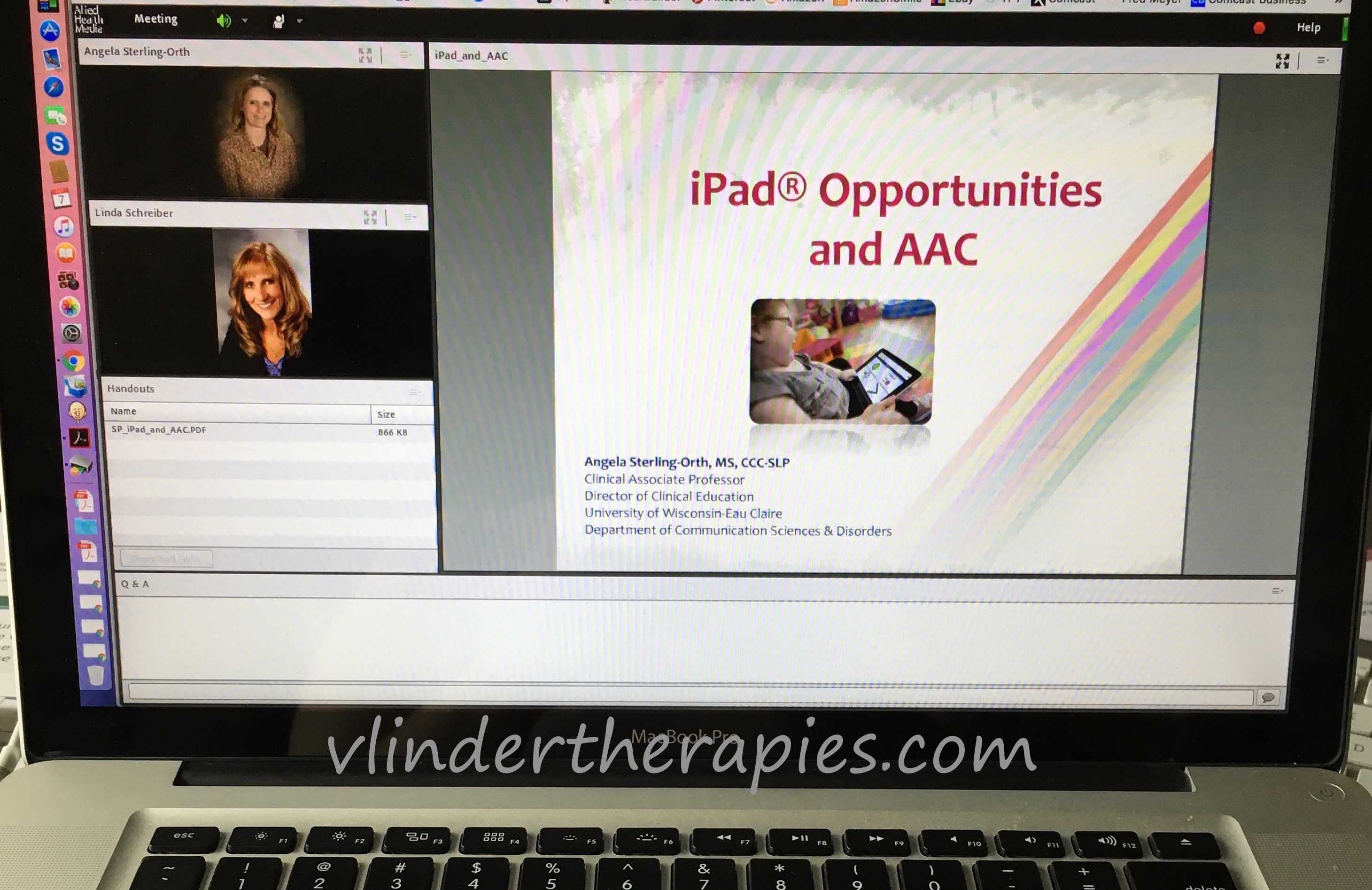2016 Nancy McKinley Lecture Series: Topics in AAC {Day 5}
October is AAC Awareness Month! All this week I am attending a live webinar series on SpeechPathology.com called:
2016 Nancy McKinley Lecture Series: Topics in AAC

Day 5
iPad Opportunities and AAC
Presenter: Angela Sterling-Orth, MS, CCC-SLP
Our final topic this week was presented by Angela Sterling-Orth, MS, CCC-SLP, Clinical Associate Professor at University of Wisconsin - Eau Claire. She encouraged us to think about the potential usefulness, and potential pitfalls, of using the iPad as a tool for individuals with complex communication needs.
While Angela could have focused solely on using the iPad as a speech-generating device, she took a broader approach to goals for using an iPad for AAC. To maximize its potential, we need to think about the individual's entire life - and thinking functional! For individuals with complex communication needs, potential applications for using the iPad include:
- as a dedicated speech-generating device (as an alternative form of communication), which addresses intelligibility issues*
- supplemental to oral speech to increase participation (as an augmentative form of communication), which addresses comprehensibility issues*
- as a means (educational tool) to level the playing field for learning, also addresses comprehensibility issues
- to increase opportunities for recreation/leisure, which addresses quality of life issues
- to support management of executive functions, also addresses quality of life issues
*for an explanation of intelligibility vs. comprehensibility, see my post about Dr. Cumley's talk for Day 2 of this lecture series; Angela noted that "comprehensibility" is the big picture message the individual is trying to communicate is understood, versus the communication partner understanding the intelligibility of individual words spoken
Angela expanded on the idea of Feature Match in assessment (part of the SETT process) covered earlier in the week by Dr. Cumley. With regards to the iPad, feature match needs to be divided in to two large components:
- GENERAL Feature Matching (iPad versus other SGD/AAC device)
- consider client request/interest/needs
- consider cognitive level/potential for literacy
- consider sensory limitations
- consider motor skills
- consider speech/language skills
- consider financial aspects
- SPECIFIC Feature Matching (once iPad has been determined the route to go, choosing the specific communication app and needed accessories)
- consider symbol set (text, icons, photographs, vocabulary size, display appearance/flexibility)
- consider access/input (touch, stylus, switch, keyboard, scanning, other options/accessories)
- consider output (text-to-speech, feedback, digitized versus synthetic voice, ability to save/print messages)
- consider customization (symbol set, overlays [static/dynamic], voice/output, ease/difficulty of use [for both the individual and those supporting the system], expense)
Ways to trial apps (a must!):
- use YouTube to see it in action
- App Store reviews and descriptions
- Lite versions
- contact the app developer
- network with other SLPs
- check a local lending library to see if they have it to borrow
- use a checklist or rubric (such as this one from PrAACtical AAC)
Some thoughts on avoiding pitfalls of using iPad technology for AAC needs and for engineering success:
- choose the right size (iPod, iPad Mini, iPad, iPad Pro; and amount of storage)
- choose the right app (via a rubric and comprehensive feature matching)
- use external speakers
- establish appropriate mounting and accessories (including protective cases/screen protectors)
- facilitate the client's access
- LEARN the device and the app (and TEACH others - remember this is a team process)
- treat it as the client's voice (biggest potential pitfall is "device confusion" = client not able to use the iPad as BOTH communication system and other things, such as visual schedule, fun, reading books, etc.)
It was a great week of AAC webinars! While I attended the series live, they were all recorded and are now available on SpeechPathology.com (referral link - it won't cost more for you, but I will earn a credit if you decide to sign up).
Here are links to my summaries for the other lectures in the series this week:
 Friday, October 7, 2016 at 8:19PM
Friday, October 7, 2016 at 8:19PM  Post a Comment →
Post a Comment →  AAC,
AAC,  AAC Awareness Month | in
AAC Awareness Month | in  AAC
AAC
Reader Comments